Hello dear readers, I hope you are all doing well in the respective corners of the world in which you reside. I’m so happy for those of you whom I know who are graduating from college, both least week and this week back in the States. It is another step in life that is rewarding. Don’t get hung up on the job field to much, college is more that just to get degree. College is to develop good life experiences and to exchange ideas. All of my blog this time around is going to focus on my trip to Georgia, so get a drink of lemonade or tea (or a beer, even better) and relax. Get ready for an info load on a country that is near and dear it me and has so much to offer in regards to culture, food and sites to see and it’s visa free.
Georgia is a country located in the cross roads between the Eastern and Western Worlds. Generally speaking, the country is considered a part of Europe, and the Georgian people themselves would describe their nation as a part of Europe, especially after the fall of the Soviet Union, the nation pivoting toward NATO and the European Union. I say that today this is certainly true, but I would also remark that Georgia’s geo-historical past and location also gives it many Eastern characteristics. Georgia is located in between the Greater Caucasus and Lesser Caucasus Mountain ranges. To the north is the Russian Federation, to Georgia’s direct south is the nation of Armenia and to the southwest, Turkey. In the southeast the country borders Azerbaijan, making it the first of the three “Caucasian States.” Georgia’s geographic location has made it both a treasure trove of history and artifacts from the Hellenic Era and from the Ottoman and Persian Empires, but as a consequence, the country has been invaded several times, most notably by the Mongol hordes, the Ottoman Empire, Persia and by Russia. This has given the Georgian people a strong sense of pride and longing for independence, something they finally got as a nation in 1991. As some of you may remember, Georgia was recently invaded by Russia in 2008, displacing thousands of people and creating the regions of South Ossetia and Abkhazia as semi-autonomous territories under Russian military and political supervision. The Georgian government views these regions as occupations of their lands, an issue which is still hotly debated within the international community.
This latest event has made getting to Georgia from Russia a complex process of border checks and reviewing of passports. The only way for most Westerns to enter Georgia from Russia by car or bus is by the route of the “Georgian Military Highway,” as it’s been dubbed. This road has historically been the most reliable way to get through the Greater Caucasus and many invading armies have used this route to get between both Western and Eastern Worlds. The first recorded army to cross through these paths was Alexander the Great’s, on it’s way to the Hindu Kush. Likewise the Russians used this same road to roll their tanks into Georgia, repeating an age old process and adage, “Location, location, location.” After recovering from a stomach virus two days before, I felt well enough to travel, so Diogo, Jeanne and I headed to the bus station in Pyatigorsk on the morning of the 30th of April (my sickness delayed our departure for a day). After much negotiating, we managed to find a driver who was willing to take use to Vladikavkaz, the first stop on the journey as there are no direct routes from Pyatigorsk to Tbilisi (the capital of Georgia, and our destination). We crammed into our drivers mini-van and sat for 3 hours, enjoying the landscapes of Kabardino-Balkaria and North Ossetia-Alania.
Upon arriving in Vladikavkaz, Diogo contacted a driver who makes his living ferrying people across the borders of Russian and Georgia and he meet us at the bus station. We had a bite to eat at a local cafe, munching on a mix of Ossetian pies filled with cheese and potatoes. This was a huge meal which we need before our drive (we even had a box of pies to take us with us, which we ate later when in Tbilisi). The drive got interesting when we changed drivers outside of Vladikavkaz, our driver replacing himself with his son. As we started driving I was reminded about how crazy people can drive around here and we’re very lucky to have arrived in Tbilisi that evening in one piece. Besides having a crazy driver, that drive in of itself was good. I was looking forward to driving through the mountain passes and seeing up close the towering peaks that I gaze at from here in Pyatigorsk. The mountains were very impressive, once we got in them. My lovely drive was delayed for two hours however, as we got to the border check point in Dariali, Russia. Barbed wire, road blocks, lines of semi-trucks and uniformed men with AK-47s become the new view and part of our trip. Our driver may have driven crazy, but I was happy to have him, as he knew (or seemed to) every guard and official who we came across when at the border. We even managed to skip all the traffic exiting Russia (a good 30 cars) and get to the head of the line with no problems. We then gave our passports to the authorities and they checked our information. The three of us were then taken into separate rooms where FSB agents (Russian Federal Security) questioned us for over an hour. They asked for my “life story,” who I was, who my parents were, why was I studying in Russia, why I was going to Georgia, where in Georgia etc. It was a process that I was familiar with when coming back from Tbilisi during my first trip, two years ago, being questioned by the airport authorities in Mineralnye Vody. It’s just an annoyance as it takes a lot of time. I’m sick of bring called a “spy.” All I want to do is get some cultural experiences, learn interesting history, see great sites, and eat tasty food.
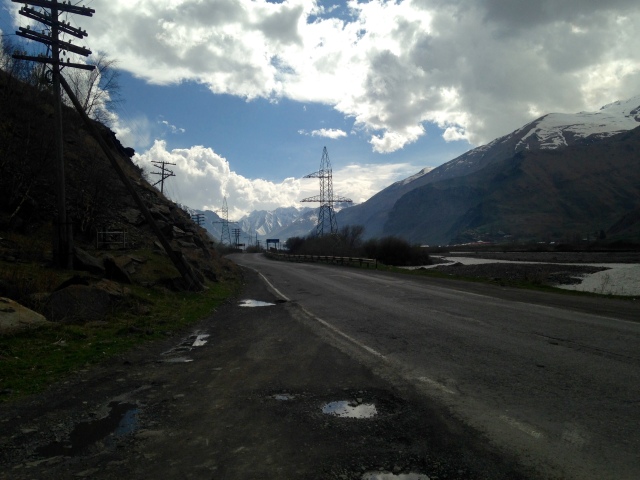
After being treated to the wonders for Russian border personal and their “hospitality,” we got on the road to drive through the Darial Gorge. A fun fact about this geographical point is that it is the only land route to Georgia that is wide enough for tanks. This is way the Russians invaded Georgia in 2008 by this route. The geology and topography are very different on this side of the Caucasus. The mountains here are rich in iron, so it reminded me a lot of the Colorado Rockies, as the rocks are almost a blood red in color at some places. The mountain slopes are covered by alpine forest, that is usually surrounded by arid glasses, but it rained a lot before we arrived so the plant life were vibrant shades of green. In general, the landscape of eastern Georgia has numerous valleys and gorges that are separated by the mountains. Looking at these gorges from high elevations was a super cool moment. We passed the town of Stepantsminda, a tiny, cute village on the Military Highway. We stopped near a natural mountain spring and drank from it. The water was so cold and clear. It was amazing to know that I was drinking water from several hundred feet up. The range of mountains we were driving through is called Kazbegi, named after Mount Kazbek, one of the dominant landmarks in the region. As we traveled farther on the road the landscape rose to a 12% grade and we quickly ascended to 2,500 meters (about 8,202 feet). The view was breath taking. Our taxi driver stopped on the road near the town of Sioni (there are many towns and monuments in Georgia named Sioni). You can see all of the valley and the mountains from this point and the lake below was beautiful.
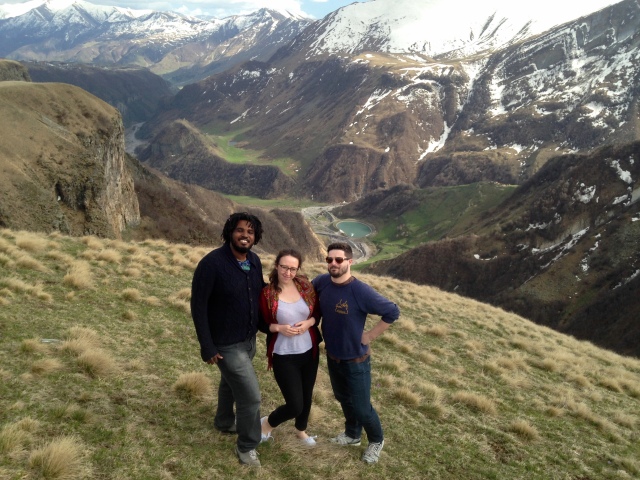
We then slowly descended down the mountains. From the car window we could see all of the ski resorts and the cafes. This region is famous for its resorts and it most be packed in the winter months during the ski season. I was informed by our driver that the snow begins in October and can snow until May. There was a lot o snow in the mountains when we drove up and I was surprised to see it. Descending was great as we really got to see the changes in topography that Georgia is famous for. Deciduous forests covered the valleys and all the flowering species of tree were in bloom. From the look of the trees I’d say that there are a lot of varieties including: maple, ash, and hazelnut. As we traveled from the Upper Alazani Valley, the forest became that of yew tree. Georgia is one of the few countries in the world that claim all but two of the biomes, lacking tundra and taiga. With is diverse climate and geography, the country has an incredible list of animal and plant life. Georgia is home to over a 1,000 species of vertebrates including: 330 birds, 160 fish, 48 reptiles and 11 amphibians, as well as bears, wolves, lynxes, Caucasian tur (a kind of ram) and the rare Caucasian leopard. Georgia even has 501 different types of spiders (a fact I’m less enthused about).
Before we arrived in Tbilisi, we stopped at the town of Natakhtari. This is yet another tiny village on the road, but it is home to one and only Natakhtari brewery, which produces some of the most famous and tasty beer, lemonade and soft drinks that the country has to offer. Our taxi driver as kind enough to give to me as a gift, a bottle of Natakhtari grape favored lemonade. It is tasty and similar to grape soda in the States. We arrived in Tbilisi in the late afternoon and hired another taxi driver to get to our hostel which Diogo had kindly reserved for us a few days in advance. The hostel is called “Grape Hostel.” It is a nice place as far as hostels go and our ten day stay was comfortable (much more so than I had expected). The location wasn’t bad either. We were based on 11 Jansughi Kakihidze Street, on the east bank of the Mtkvari River. After a good night sleep, we decided to get metro passes which was a brilliant idea. Out of metros that I’ve ridden on, Tbilisi’s is by far the best (though I say this coming from a region in America that lacks metros, so this is just from my experience) as it is easy to navigate and very cheap. We were only two metro stops away from Liberty Square (one metro stop from the famous Rustaveli Avenue), the central point in the city, displaying a tall stone pillar with a golden statue of Saint George, the patron saint of Georgia. The area we lived in was the fashion center of the city. Shops selling both French and Italian brands hung in the windows. It was also an area that had a lot of Turkish restaurants and maybe these establishments cater to Turkish tourists or immigrants (or both). It isn’t surprising because Turkish culture has heavily influenced the region as a whole as well as the fact the Georgia and Turkey share a border.
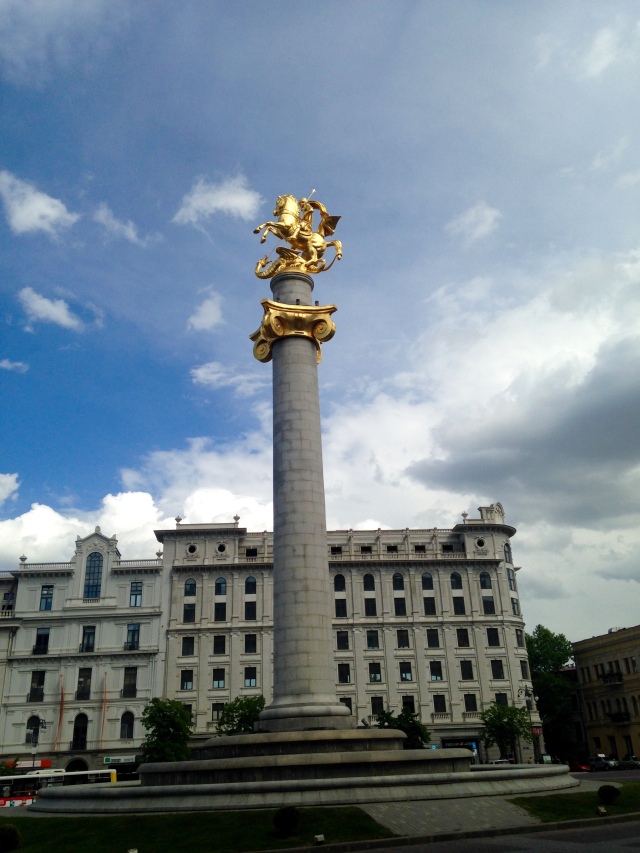
Tbilisi is home to around 1.5 million people, but the city feels like Omaha. The city was founded back in the fifth-century by the King of Iberia (the name of the eastern region of Georgia from the antiquity). The city has been also been called Tiflis under Russian Imperial rule (1801-1917), and was the seat of the Imperial Viceroy who governed the Caucasus. Tbilisi has throughout history, benefited from the lucrative Silk Route trade and this intern has influenced the cities architecture with elements of medieval and classical varieties from both the Eastern and Western Worlds, as well as some Soviet elements (thankfully, I saw little of the Soviet blight on this beautiful city). Tbilisi has been the historical and cultural capital of Georgia since at least 1122, when King David the Builder entered the city after his battle with the Seljuk Turks, uniting the regions of Iberia and Kutaisi (Western Georgia). This event then started the Georgian Golden Age from the 12th to 13th centuries. The city is also an important literary and religious center for the Georgians. During the Georgian Golden Age, the Georgian alphabet and the Georgian Church were very influential. A great example of this is Shota of Rustaveli’s (Shota Rustaveli, named after where he was from), poem, The Knight in the Leopard’s Skin, a work consisting of over 1600 Rustavelian Quatrains. It is considered by Georgians as a “masterpiece in our nations literature.” Until the 20th century, a copy of the poem was a part of a brides dowry, as the poem itself displays elements of Georgian culture, an allegory to the rule of Queen Tamara of Georgia, told through a chivalric romance.
Here are a few lines from the poem that I’ve looked up. Here is the prologue:
“თამარს ვაქებდეთ მეფესა სისხლისა ცრემლ-დათხეული,
ვთქვენი ქებანი ვისნი მე არ-ავად გამორჩეული.
მელნად ვიხმარე გიშრის ტბა და კალმად მე ნა რხეული,
ვინცა ისმინოს, დაესვას ლახვარი გულსა ხეული.”
“By shedding tears of blood we praise King (Queen*, Rustaveli emphasis Tamara as “King” as she is so important to him) Tamara, whose praise I, not ill-chosen, have told forth. For ink I have used to lake of jet, and for pen a pliant crystal. Whoever hears, a jagged spear will piece his heart.”
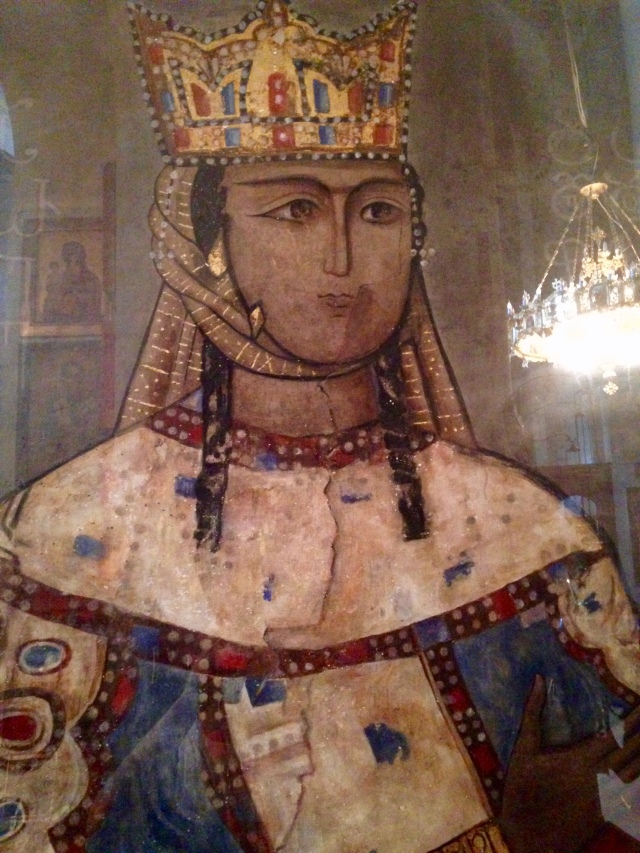
Powerful words. I can see why the Georgians would put such an emphasis on Rustaveli. The Georgians are also very proud of their alphabet, one of the few in the world that is original, forming in the 1st millennium BC in Iberia. The language is split into three subgroups of the greater Kartvelian (Georgian in Georgian) languages, the others being Svan and Mingrelian. Old Georgian even has been documented in antiquity, from writing by the Roman grammarian, Marcus Aurelius, describing the language as a “incomprehensible tongue.” The written language was a product of the conversion of the Georgian elite to Christianity in the mid-4th century, the grammar structure similar to that of Aramaic. The modern alphabet consists of 33 characters, with only 5 vowels. I personal love Georgian calligraphy and it was a treat to see it written all over the icons of the many of churches that I visited during my time in Tbilisi. I love the lopes and curves that many of the letters have. My favorite letter is the “ლ” one of the two “L” sounds that the language has. Many other famous writers have visited Tbilisi, many from north of the border. Pushkin, Lermontov and Tolstoy have all been to the city, inspiring Russian minds in Saint Petersburg and Moscow through their writings about the exotic nature and beauty of the Caucasus. Georgian poets and writers such as Ilia Chavchavadze (1837-1907), Iakob Gogebashvili (1840-1912), Alexander Griboyedov (1795-1829) and others have also called the city home at one point or another, furthering Georgian cultural influence in the region.
One of the things I wanted to do when in Tbilisi was experience the multi-confessional culture of the city. Ethnic, religious and cultural diversity has been a staple in this town. The urban folklore and language during the 17th and 18th centuries have been called tblilisuri (literally meaning, “belonging to Tbilisi”) and this has been personified by the cultural institutions and by the churches that have been built in the city. On our first full day in the city, Jeanne and I walked around Liberty Square and Rustaveli Avenue, where I spotted the first church on my long list. Kashveti Church was built between 1904 and 1910 and was designed after the medieval Georgian Cathedral, Samtasvisi. The construction was sponsored by the Georgian nobility and bourgeoisie and in 1947, Georgian painter Lado Gudiashvili painted a series of frescoes on the churches walls. The church was damaged by the Soviets, who attempted to destroy the structure, but thankfully, they never finished the job. The word kashveti, is derived from the Georgian words ka for “a stone” and shav “to birth.” I visited on Easter Sunday and unfortunately didn’t take any photos of the interior as I didn’t want to disturb the individuals worshipping there. I did however, enter the church and witness part of the service. The choir sang beautifully and the icons within the Kashveti are very beautiful, as are Gudiashvili’s frescoes.
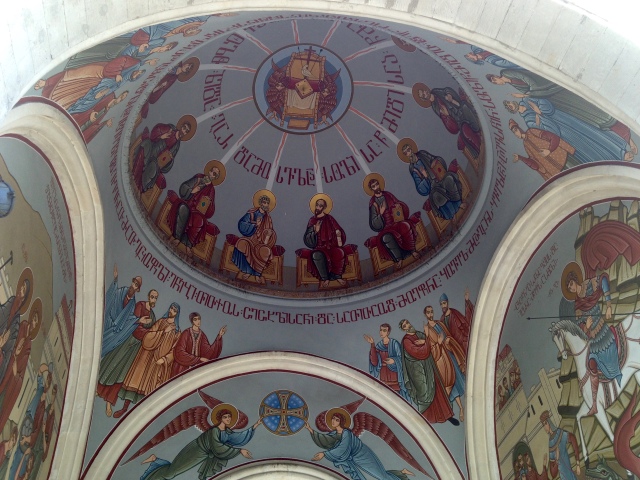
My next series of churches that I saw was on the second day. I was walking toward Old Tbilisi (the oldest part of town) and was in the middle of an alleyway filled with cafes and shops, when I turned a corner and there in was. Anchiskhati Basilica is nested in a square next to the river and if your not paying attention, you can easily miss it. The basilica dates back to the sixth century, making it one of the oldest churches in Tbilisi (commissioned by King Dachi of Iberia, 522-534). It is dedicated to the Virgin Mary. It was renamed Anchiskhati (or “the Icon of Ancha) in 1675 when the icon of the Savior at the Ancha monastery in Klarjeti (in modern day Turkey) was moved to the church in order to preserve it from Ottoman invasion. The icon was saved and it is now on display at the Art Museum of Georgia. This church has also been lucky in that it has been only damaged several times during the 15th and 17th centuries due to wars between Georgia and the Persian and Ottoman Empires. During the Soviet Era, Anchiskhati was turned into a handicrafts workshop, all of the icons being removed or destroyed. It was only after the fall of the Soviet Union that the church once again became a house of worship. The Anchiskhati Choir is based out of this church and is one of the leading exponents of Georgian polyphonic choral music, the oldest form of polyphony music in the Christen World.
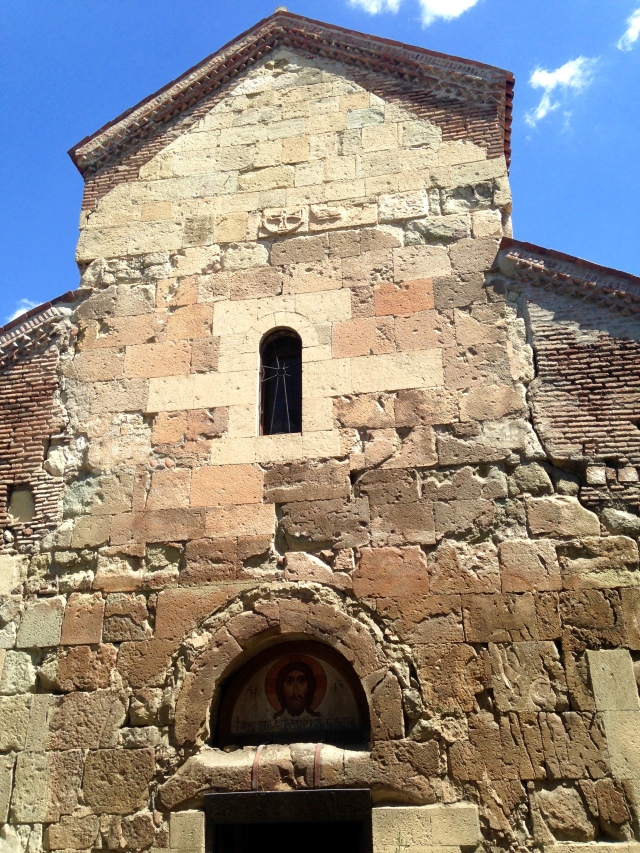
After visiting Anchiskhati, I headed across the river by way of the famous Dry Bridge and took a quick walk through Rike Park. Perched onto of a rocky outcropping, is Metekhi Church of the Assumption. Metekhi is not only a church, but it is also a neighborhood and district in Tbilisi. The whole area is elevated on a cliff that overlooks the Mtkvari river. According to traditional lore, this district was one of the earliest fortified settlements in the city, housing the residence of King Vaktang I of Gorgasali, were he commissioned a church. The name of the settlement however, is recorded in the 12th century and means in Georgian, “the area around the palace.” Legend tells that the site is the resting place of Saint Shushanik, a fifth century martyr, but little of these original structures have survived the Mongol raids of 1235. Metekhi was commissioned by King Saint Demetrius II between 1278-1284 and is unique in regards to Georgian Church architecture, as it is domed. The Church is a cross-cupola, with three projecting apses in the base facade and four freestanding pillars support the cupola within the interior. Georgian painter Dimitri Shevardnadze led an opposition movement to save the Church during the early Soviet Era, when the infamous Laverenti Beria (one of the most brutal men in the Soviet leadership at the time next to Stalin), ordered the Church to be destroyed. Shevardnadze was imprisoned, but the Church was never destroyed, the Communist leadership turning Metekhi into a theatre. Outside Metekhi, there is an equestrian statue of King Vakhtang I of Gorgaslan (sculpted by Elguja Amashukeli, erected in 1961), commemorating a strong leader in Georgian history and the legend of his commissioning of the settlement. Metekhi has beautiful stone engraving on the arches and on the door fames.
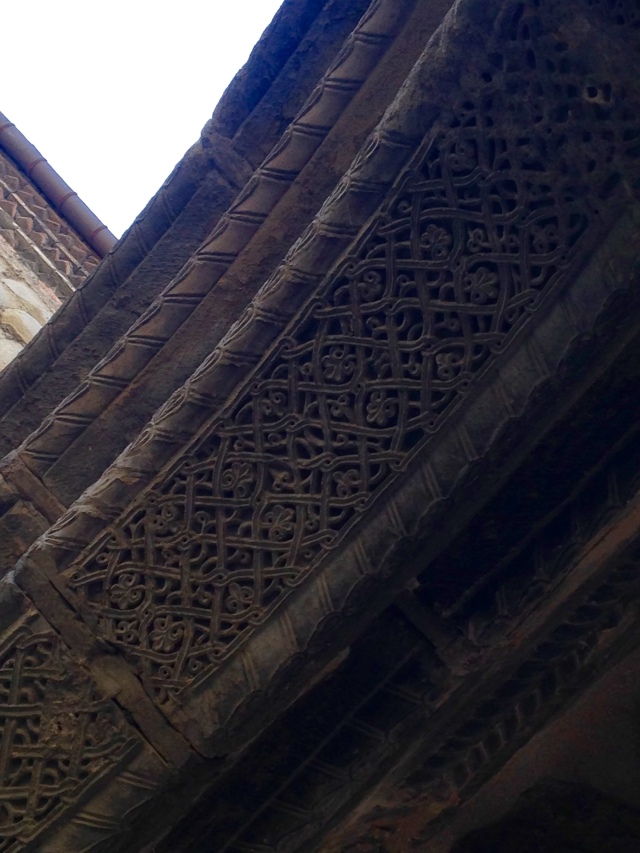
After my visit in the church, I stopped at a local wine vender within the Metekhi neighborhood and asked the owner a few questions concerning Georgian wines, specifically the regional differences in regards to favor and types of wines used. I was given the opportunity to sample a few vintages of wine. I especially liked the Akhasheni, a semi-sweet red from Badagoni Wine Company, located in Zemo Khodasheni, Georgia. It is a nice example of traditional Georgian wine made from the Saperavi grape (a species native to Georgia) within the Kakheti region. The favor was described as a having a “dark-pomegranate color and a velvety taste with hits of chocolate.” It was very tasty so I brought it, at a reasonable piece, 25 lari ($12.5). I then crossed the bridge to Old Tbilisi and I headed to Saint Gevork of Mughni Church. This is my first Armenian church to visit and it was a wonderful experience as the interior was beautiful. The Church was originally built in the 13th century, destroyed and later rebuilt in 1756. During the Soviet Era, it served as a museum of folk art, the interior ruined by pro-Communist demonstrators in 1991. In 2009, the churches dome collapsed, but it was rebuilt with government funds and donations from Armenians both in Tbilisi and in Armenia (as well as from Armenian Diaspora). The churches icons have all been donated and it is amazing to see how beautiful the Church is now, knowing that it has been in pieces.
As I was walking around Old Tbilisi, I ran into a friend from mine who I met in Volgograd. Fabian is a Germany student who Diogo and I spent so time with during the Model UN there and when we talked about our trip to Georgia, Fabian informed us that he lived and worked in Tbilisi for two years, knew the sites and spoke Georgian. He and I talked and said if we met we in Tbilisi, he’d show me some of the city. By the winds of fate, I saw him standing in near a restaurant by the Saint Gevork of Mughni Church. I called out to him and he started looking around until he saw me waves my arms up and down like a chicken. We embraced and he invited me to sit down with him and share a Georgian meal. We met up with a friend of his and ordered several Georgian staples including: khinkail, khachapuri (Mingerlian/Megruli are region in Georgia, with cheese filling and cheese baked on top of the bread), sulguni cheese, stuffed mushrooms, lobiani (sort of like refried beans with cilantro, cooked in a clay cup), and Saperavi wine. It was a delicious and savory feast.

The three of us then headed to Rike Park and got on a ski lift to got to the top of Narikala Fortress, an ancient wall overlooking Tbilisi. The fortress consists of two walled sections on a steep hill between the sulfur baths and the botanical gardens of the city. On the lower court there is the Church of Saint Nicholas, with a beautiful inter section decorated with frescos showing scenes from the Bible and Georgian history. The fortress was built in the fourth century and was expanded in the seventh century and also by King David the Builder during the 11th century. The Mongols called the fortress “Narin Qala,” or “The Little Fortress.” Parts of the fortress has been damaged by war and by earthquakes. The view from this vantage point is spectacular as you can see all of Tbilisi and the statue of Mother Georgia stands strong and proud. In her right hand is a sword and in her left hand is a bottle of wine. Symbolically, wine is a representation of Georgian blood, and when friends drink wine together, they are “sharing blood.” Mother Georgia defends this “blood” with her sword.
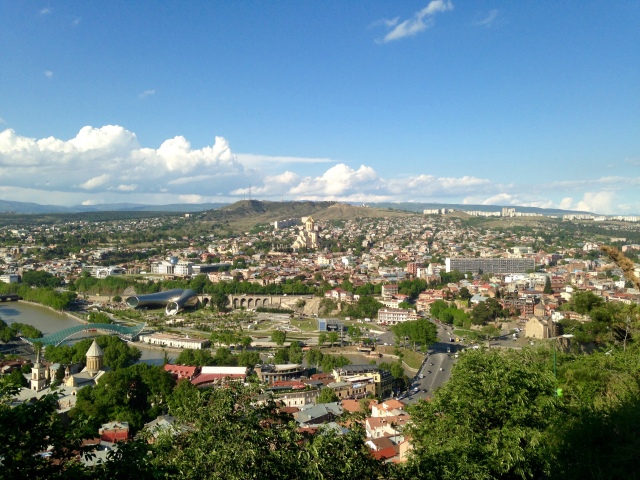
My last church to visit on that day was Sioni Cathedral at Tbilisi, is of medieval Georgian tradition in regards to architecture and the name. Sioni in Georgian is translated to “Mount Zion” in and is distinguished from other sites which bear the same name, by adding the “at Tbilisi” bit. The church is located on the eastern bank of the Kura River, on Sionis Kucha Street and was built in the 6th and 7th centuries (the cathedral was completed under the leadership of King David the Builder in 1112). Since that time, the church has been destroyed during invasions (once by Arab armies in the 7th century and again by Timerlane’s Timurid hordes in 1386) and rebuilt (a common theme within Tbilisi’s church history). The church was also devastated by an earthquake in 1668, much of the structure and the southern chapel having to be replaced. The current church is based on the 13th century version with some remodeling work from the 17th and 19th centuries. Sioni Cathedral was the main Georgian Orthodox Cathedral and the seat of the Catholics-Patriarch of All Georgia until the Sameba Holy Trinity Cathedral was consecrated in 2004. The cathedral has a beautiful interior with both medieval frescoes and modern murals. The murals were painted by Russian general Knyaz Grigory Gargarin (1810-1893) between 1850 and 1860. Another section of murals on the western wall were painted by Georgian artist Levan Tsutskiridze in the 1980s. There is also a stone iconostasis that dates back to the 1850s, replacing a wooden one that was burned during the Persian invasion of Tbilisi in 1795. At the left of the altar, there is a venerated Grapewine cross which, according to legend was forged by Saint Nino, a Cappadocian (central Anatolia, or modern Turkey) woman who preached Christianity in the Caucasus during the early 4th century. The cathedral is the famous site of the signing of the Russian Imperial manifesto on the Annexation of Georgia on April 12, 1802, by Russian General Karl von Knorring and the assembly of Georgian nobles (any nobles who disagreed, were imprisoned). Unlike many of its sister churches, Sioni reminded an active place of worship during the Soviet Era. It is my favorite church in Tbilisi.
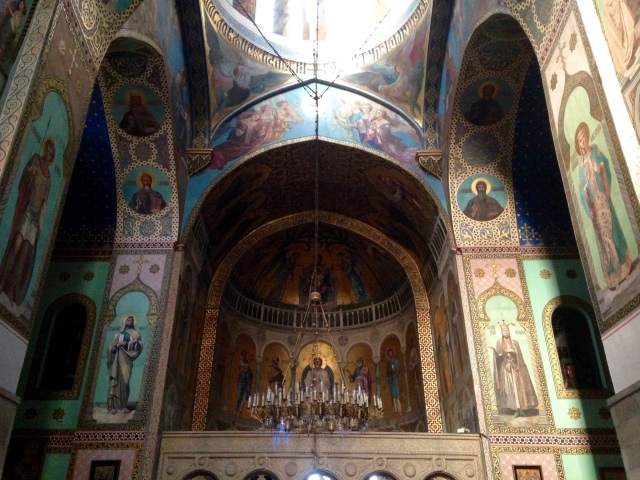
After three days in Tbilisi, we all headed to the town of Mtskheta. After much searching at one of the several bus stations, we managed to find a marshotka going to the town. It is about a 20 kilometers (12 miles) north of Tbilisi, located on the confluence of the Aragvi river. It was only about a 33 minute drive, which was good, because the marshotka was packed. After we arrived in Mtskheta, I recommended that we stop by and eat something as in was around noon. I had read of a nice place online called Salobie Restaurant. Little did we know that the restaurant was three kilometers from the town, across the river. As we were figuring out what to do, we met a Dutch gentlemen named Peter who had traveled with us on the marshotka. He asked us questions about what to see in the town and we invited him to join us for lunch. By luck, there was a taxi waiting near by, so the four of us got in a drove to the restaurant. It was nice place, with a brewery, wine cellar and outdoor tables. We sat outside to enjoy the warm, sunny weather. We helped explain to Peter some of the dishes in Georgian cuisine and I ordered a Adjarian (Acharuli/Adjaruli) khachapuri with some khinkali and of course a liter of Saperavi wine, as well as a glass of ice cold beer. It was a wonderful meal and I’ve become a convert to Georgian wines, but I prefer semi-sweet reds anyway, so it works out well. After our meal, we discussed our next plan, either head to Mtskheta first or to go up the huge hill overlooking the city to see the Jvari Monastery. We decided to head up to the monastery, but we need transport. In the end we hitched hiked to the monastery, which I must confess was my first time doing say activity.
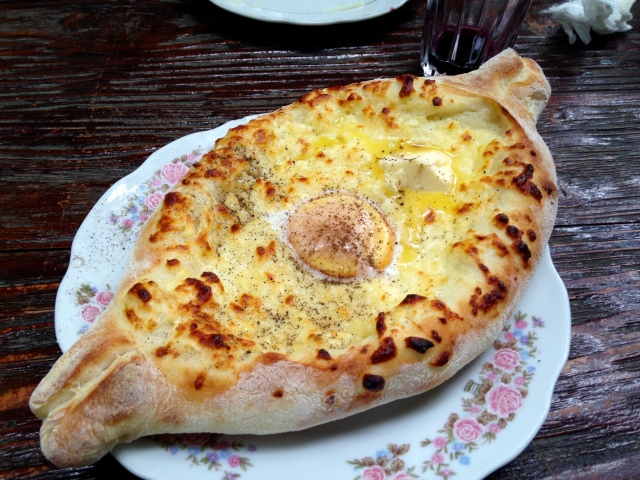
The Jvari Monastery stands on the rocky hilltop at the confluence of the Mtkvari and Aragvi rivers. According to legend, the monastery was built on the location where Saint Nino converting King Mirian III of Iberia (Eastern Georgia) to Christianity in the 4th century. The foundations of Jvari are built on the ruins on a pagan temple. The site was first marked by large wooden cross, which reportedly drew pilgrims from all over the Caucasus. The present building is generally thought to be built between 590 and 605 by Erismtavari Stepanoz I. This is based on the Jvari inscriptions on it’s facade which mentions the principal builders of the church: Stephanoz II, Demetrius (brother of Stepanoz I), and Adarnase II (son of Stepanoz II). During the Soviet Era, Jvari was preserved as a national monument, but across to the site was limited. After Georgia gained it’s independence in 1991, Jvari was restored to active religious use and was listed (along with several other monuments in Mtskheta) as a UNESCO (United Nations Educational, Scientific and Culture Organization) World Heritage Site in 1994. Thankfully, the monastery has never been destroyed, but there is concern for the structure, as it has suffered centuries of wind and water erosion, along with inadequate maintenance. Jvari is one of the earliest examples of four-apses churches with four niches and a domed tetraconch, with an open central interior and that transitions to a square central bay to the base of he dome’s drum. This is an architectural style that is unique to Georgia, Armenian and in Caucasian Albania. Jvari is believed to have influenced other styles in the region. It was so good to literally touch history, as I walked the grounds of this holy site and entered the monastery. The stones and facades looked ancient, much of the paint faded, by time. It was my first UNESCO site to have seen one my visit to Georgia.
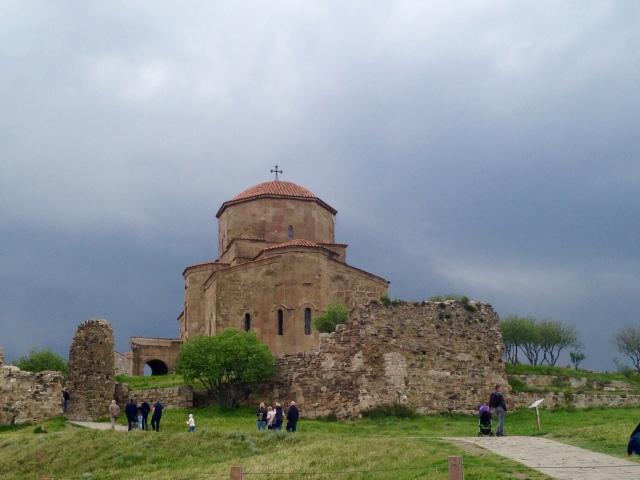
After observing the monastery, paying my respects to Saint George and soaking in the amazing scenery, we managed to find another taxi driver and we headed back down the huge hill and reentered Mtskheta. The town is older that the monastery, being built in the 5th century BC, making one of the oldest settlements in the country. It was the capital of the Georgian Kingdom of Iberia (modern Kartli) form the 3rd century BC to the 5th century AD. It has been a town of Christian pilgrimage since 337 and remains the headquarters of the Georgian Orthodox Church, being declared a Holy City b the Catholicos-Patriarch Ilia II of Georgia in accordance of the written testament of his 11th century predecessor, Melchizedek I of Georgia. The town also is home to Svetitskhoveli Cathedral of the Twelve Apostles (svetitskhoveli meaning “the living pillar”), another UNESCO World Heritage Site. The cathedral was originally built in the 4th century and was damaged several times during the various invasions by Arabs, Persians and by Timurlane’s Timurid hordes. Over the centuries, the church has been built in layers, with the basilica added in the 5th century, followed by the present cathedral in the 11 century (between 1010 to 1029) in a cross-dome style by the architect Arsakidze. A relief on a sculpture on the external northern wall, reads: “The Hand of Arsukidze, slave of God, may forgiveness by his.” The cathedral is also surrounded by a defensive wall, commissioned by King Erekle II in 1787. Svetitskhoveli, is known as the burial site of Christ’s Mantle, as many famous and important priests, soldiers and nobles are buried here on the cathedrals grounds. The cathedral is so huge and I can only compare it to Saint Issac’s Cathedral in Saint Petersburg, in regards to it’s size and awe. The iconostasis is magnificent and it is the icons depicting the Stations of the Cross are carved in wood, in great detail. It was so humbling to be on the grounds of such a holy and historical site, feeling the atmosphere of Georgia’s version of the Vatican. Of the churches that I saw on my trip to Georgia, Svetitskhoveli is my favorite. On the way back to the bus station in Mtskheta, I bought myself some homemade churchkhela from a local stand and quickly visited the Shiomghvine monastery (another beautiful religious site in Mtskheta), before the last buses left for Tbilisi.
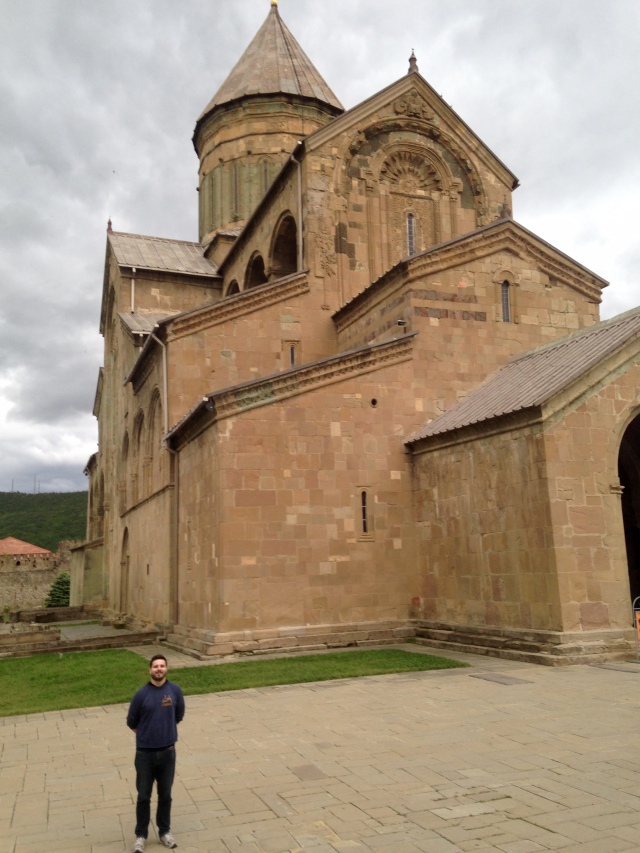
After a restful nights sleep, I awoke and started my next round of religious site touring in Tbilisi. Diogo and Jeanne came with me during this excursion. We walked over to Old Tbilisi and saw the sulfur baths (I may case revisited), built by the Romans and then improved by the Ottomans and also enjoyed the nature around the streams, included a pair of frogs that were having a competition of who could make the most noise. We then headed to the visit the Juma Mosque. It looked very similar to the White Mosque in Astrakhan, in regards to it’s interior. The exterior is red brick and at first I didn’t even recognize the building as a mosque until I saw the golden crescent on the point of the tower. Enhancing the religious diversity, we stumbled upon the Great Synagogue on the edge of Old Tbilisi. The building was in a similar design of the Juma Mosque, red brick in all. After walking around most of Old Tbilisi, we needed a rest from the May heat. So, what better way to freshen up then to stop at a brewery. We happened upon Alani Brewery, a local joint in Old Tbilisi, that has one of the best beers in the Caucasus. Having a glass of unfiltered, golden colored heaven was just what I needed. We also had a half a liter of Saperavi wine between the three of us. Wine culture in Georgia dates back eight thousand years and one must have wine when you sit down to have a meal. It spirit of this tradition, I’ve gotten for myself several drinking horns, made of cow and ram horn, with silver embroider. The perfect gifts from Georgia, wine and a horn to drink it from. On the way back to the hostel, we saw the Assumption of the Blessed Mary Roman Catholic Church, an unexpected thing to see, as I’ve never seen a Catholic Church in this part of the world before.
On the 6th of May we when traveled to the city of Sighnaghi. This is a town in Georgia’s easternmost highlands in the Kakheti region and is one of the most popular tourist destinations due it its location in the heart of Georgia’s wine country. Diogo, Jeanne and I met up with our friends Alizee, Florane, Molly, and Maddy (who were meeting us during their return from their own visit in Armenia) at one of bus stations (having several changes in departure as we needed to find the right station to leave from Tbilisi to Sighnaghi). The morshotka wasn’t to expansive for our 2 two hour drive, get the vehicle was packed with people. I wanted to see the scenery on the way, but I wasn’t able to. The view when we arrived however, made up for it. The town is located on a very steep hill/mountain (it’s 2,743 feet up) that overlooks the vast Alazani Valley, with the Greater Caucasus Mountains visible at a distance. The view was fantastic. I heard of Sighnaghi through watching a documentary on cultural sites in Georgia a few months back when I was doing research for our trip. I was sold when I learned that the area is famous for its wine making. The town was settled as a series of vineyards and gradually developed into a town during the 18th century, King Heraclius II sponsoring the construction of the town as well as a fortress to defend the area from raids by tribesmen from modern Dagestan. We toured several churches during a day all stay, including the Church of Saint George and Saint Stephen’s Church. We took some really nice group photos within the bell towers of Saint Stephen’s, another great vantage point to see the Georgian country side. The best part of our visit was going to the winery and restaurant, Pheasant’s Tears. I had read about them online and emailed them for a evening of wine tasting and to experience a Georgian supera, or “feast.” We had four different types of wine, and five courses.
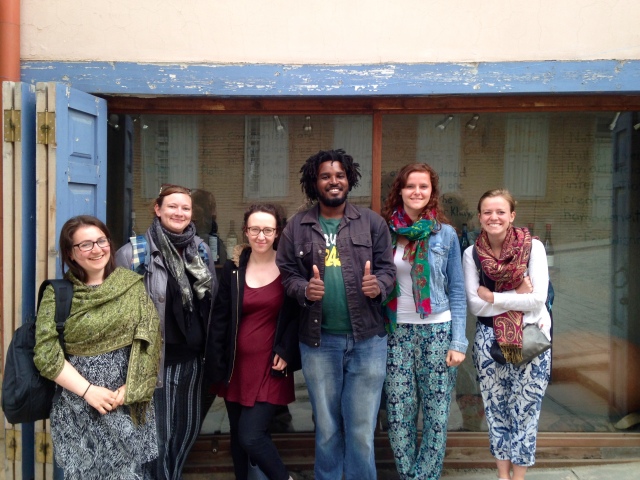
We started our first course with an assortment of Georgian cheeses. We had some thick pieces of Imeruli cheese (a salty cheese that reminded me a lot of Kabardian or Adyghe cheese), some Nadugi cheese (somewhat like a garlic chive) and qarkhnuli, a cheese with the consistence of yogurt. The wine paired with this course was called Chinuri, (a dry white wine). We then began our second course with a wide variety of vegetable dishes. Maddy was in heaven, saying that the dinner was “one of the top ten meals I’ve had in my life,” a sentiment to which I then toasted to. I played tamador (in Georgian culture, a person who gives toasts for family, friends etc. between courses) that night. We had ispanaskhi matsvnit, a salad dish comprised for cooked and minced spinach mixed with yogurt, garlic and cilantro (oh, how I love cilantro), along with several other salads and “Georgian style” baklajon (a grilled eggplant dish). We had another white wine paired with this course called Mtsvane (a dry white with a fruity favor). Our third course was chicken tabaka, a dish cooked by pan frying the meat. It was very well seasoned with paprika, garlic and cilantro, making it one of the best tasting meals that I’ve had in the Caucasus. The wine that was paired with meal was a Saperavi (the most famous red wine and grape in used in Georgian wine making). Another plate was served, featuring home-style potatoes with tkemali (a plum sauce). The fourth course was a full pie of Imeretian khachapuri. Our final course was a pork mtsvadi (similar to North Caucasus shashlik). The last wine pairing was a delicious glass of Tavkveri (a semi-sweet red, with a fantastic floral bouquet).
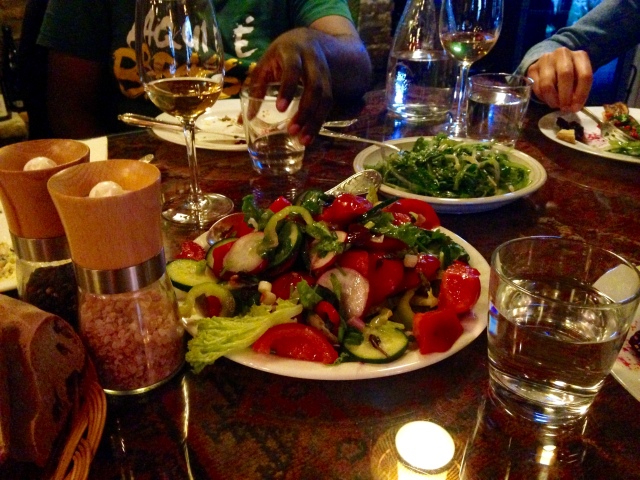
Pheasant’s Tears ferment their own products and grew their own grapes for the wine that produce (the vegetables served during our supra where also grown locally from the groups of the winery/restaurant). All the wine we tasted was from Pheasant’s Tears, in the fashion of the Kakheti region and through the traditional process of using the kvervri clay jars, which have been listed on UNESCO’s “Intangible Cultural Heritage Lists.” I cannot stress enough the importance of Georgian viticulture in our world today. For the last 8,000 thousand years, the peoples living in the regions of Kakheti, Telavi, Kvareli (Eastern Georgia) have perfected their fermentation processes using kvevris to store and wine for aging, the interior of the clay lined with bee’s wax. There are several varieties of grapes that are native to Georgia, including the Saperavi, Alexandrouli, Mudzhuretuli, Tsitska and Tsolikauri. The natural springs and rivers in the Caucasus Mountains drain mineral-rich water into the valleys where the vineyards are located. Georgia’s moderate climate and moist air (influenced by the Black Sea), provide the prefect conditions for vine cultivating. The soil in Georgian vineyards is so intensively cultivated that the grape wines grow up the trunks of fruit trees eventually hanging down the fruit then they ripen. This method is of cultivation is called maglari in Georgian. Having a supra at this place was an incredible experience that I will never forget and sharing it with friends was even better. Our enjoyable day had one speed dump, getting back to Tbilisi. All of the marshotkas stopped driving between the two cities at 6 o’clock in the evening, so we needed to find a taxi. Of course this late at night, the prices were expansive and after an hour of waiting and negotiation (as it rained), we finally gave in took two separate taxis, Diogo, Jeanne and I in one taxi, and Molly, Maddy, Alizee and Florane took another, as we lived in separate hostels.
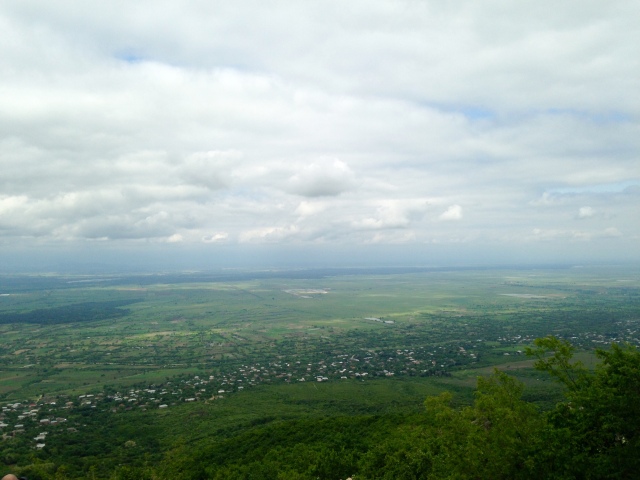
During our final days in Tbilisi, I then went on museum touring. I first visited the Georgian National Museum. This is a great museum, as it has four different sections including: Prehistory, the Archeological Treasury, the Museum of Soviet Occupation, and the Oriental Arts Exhibit. These exhibits cover Georgian history in a manageable way and chronologically, covering a wide varieties of evens, culture, and art. I first saw the exhibit to prehistory, so I come get a better understanding region by going to the beginning. This period in Georgian history is amazing, as the discoveries during the excavations at the Dmanisi site (in the south-eastern part of the country) during the last 40 years have enlightened our knowledge about the evolution of our species. Fossils that date back to 1.8 million years ago point that early humans traveled from the African continent earlier than previous thought, Homo erectus georgicus being the earliest hominid ever discovered in Europe. Fossils of mammoths, saber-tooth cats, and other prehistory animals were also on display. My next stop was at the Archeological Treasury, this as an fantastic part of the museum. The exhibit displays coins, jewelry, weapons etc. from the 13th century BC to the 18th century. The period called the Colchis Era is very interesting, as it details the cross cultural links in art, metallurgy, and in mythology between the Hellenic World (Ancient Greece) and the Colchis Kingdom (Western Georgia). This kingdom of Colchis existed from the 6th century to the 1st centuries BC and is regarded as the first “Georgian state,” a collection of Kartvelian tribes such as the Mingrelians, Lazs, and Chans who populated Georgia’s Black Sea coast. The ancient Greeks knew of Colchis and it featured in the legend of Jason and the Argonauts, in the the search for the Golden Fleece. Between the 653 and 333 BC, Colchis culture was one of the most advanced in regards to it’s knowledge in crafting gold into jewelry. One of the technics this culture developed for “panning” gold in rivers was “fleecing” it by taking a sheep skin and using it as a net, to catch the little pieces of gold, passing through the many waterways in the Caucasus. This could be the bases for the legend of the Golden Fleece, as the Greeks may have seen this process, the fleece looking gold when capturing lots of gold flakes. The craftsmanship of the jewelry, coins and only adornments was astonishing. Greek, Egyptian, Roman, Ottoman, Iranian and Russian coins were also displayed in a series of cases. Colchis religious artifacts were compared to Greek ones, showing similarities between both cultures, along with other examples including weapons, sculptures and even earrings. It was such as great feeling to have so much history at one’s figure tips (through separated by glass).

I then headed to the second floor of the museum to see the Museum of Soviet Occupation. If I only had three words to describe this exhibit, I’d quote the movie “The World’s End” and say it was “really, very, sad.” The museum was dark, I really got sense of oppression and dread just from the atmosphere. The museum covered the period of Georgia’s occupation by the Soviet Union from 1918 to 1991. 73 years of oppression, taxation, mass imprisonment and murder the Georgian people. Photographs and documents from the various decades were displayed on the walls as well as lists upon lists of the names of priests, musicians, artists, writers, and nobles who were killed by the Bolshevik authorities during the occupation. From KGB records, the Soviet authorities killed 880,000 people between 1920 and 1947. I was brought to tears when reading the name of all the people. You felt the brutally the Communism brought, people killed because they disagreed and wanted to live in a free and independent state. Georgia declared its independence after the Bolsheviks overthrow the Russian Provisional Government and established the Union of Soviet Socialist Republics. The new nation of the Democratic Republic of Georgia was founded on May 26, 1918 and was recongnized by all major European powers at the time. The new nation had several struggles at its conception, most notably, protecting their borders from the advance of the Ottoman Empire and having territory disputes with their neighbor Armenia. In February of 1921, the Red Army invaded Georgia and occupied the country, the legitimate Georgian government forced to flee. A resistance movement then fought for three years to remove the Soviet blight from their lands, a large-scale uprising forming in August of 1924, led by Colonel Kakutsa Cholokashvili. This effort failed however, resulting in the mass executions and the Sovietization of Georgia. The country only breathed in three of freedom before once again being forced into a larger entity, an entity that an American President famously called “an evil Empire.” The 9th of May holiday for me was hard to celebrate this year, as I was reminded after the Soviet victory of the 70 years of oppression not only to Georgia but to Poland, the Baltic States, and most of Eastern Europe. As I’ve said before, reading about an event and seeing it in person (the artifacts in this case, documents, photographs etc.) are two different things. Seeing and touching history brings an emotional response and better context to the facts.
After crying for a while and drying my eyes, I headed to the third floor to see the Oriental Exhibition. This is a series of private collections donated by Georgian families of paints, artifacts and traditional dresses of Eastern cultures ranging from as close as Iran to as far as Japan. It museum hosts one of the largest collections of art from the Qajar dynasty of Persia (modern Iran, 1781-1925). This style of art shows a strong influence by European art technic in painting, in which heavy application of paint and large areas of flat, dark, rich and saturated colors predominate. Many of the works on display are from the artist Kamal ol-Molk (1845-1940), one of the first Persian artists to introduce Westerns styles into traditional Persian painting. There are also several pieces of Chinese jade vases from the Qing dynasty and a set of samurai armor from the mid-18th century, along with four katanas, one of which has a hilt and scabbard made from elephant ivory. Very beautifully crafted. I also had the opportunity to visit the Georgian National Gallery, that very same day. So, in essence I did an art splurge. The permanent exhibition at the National Gallery houses a unique collection of artwork in the second floor of the Dimitri Shevardnadze National Gallery, showcasing distinguished works by some of the most famous artists in Georgia, including from impressionists, Niko Purosmanshvili, David Kakabadze, Lado Gudiashvili and from sculptor Iakob Nikoaldze. These various works were fun to see it that you can really see the political and society changes in the era overlapping pre-Soviet and post-Soviet Georgia. On the first floor, their was an exhibition by contemporary Georgian artist Zurab Arabidze called F63.9, his work using mirrors and phrases in Georgian, such as “I love you” and “You can succeed at anything.” In the basement, there is an exhibition dedicated to the Jewish community in Tbilisi. It was wonderful to see all of the artwork and crafts made by Georgian Jews.

On my last day in Tbilisi, I walked up the massive hill called Elia, in Tbilisi, to see Sameba Holy Trinity Cathedral. It was the last church on my list and I had to see it as it is the third-tallest Eastern Orthodox cathedral in the world and one of the largest religious buildings in the world in regards to total area, besides being the main church in Tbilisi. It was the first Sunday after Easter and I wanted to experience some of the service, so headed up the hill from the metro at Liberty Square and walked a long the banks west bank of the Kura River. As I walked up there I also get to see both the historic neighborhood of Avlabari and the Presidential Palace, the home of current Georgian President Giorgi Margvelashvili. When entering the ground of Sameba (meaning “the Trinity” in Georgian), there is a huge wall with gates and guards. I had my backpack searched and I was giving the “pat down” before entering the courtyard. A lot of military police and their families were on the grounds and I figured that the soldiers were praying and asking for blessing from Saint George. There is a beautiful, stone bell tower toward the left of the cathedral. I entered at 12 o’clock, so I got to hear the bells ring. The center of the courtyard has a stone walkway, flanked by pillars with carvings of different historical events related to the Georgian Orthodox Church. The cathedral is so tall, in of itself, regardless of being atop a hill (105 meters, 344 feet). You can see the cathedral from all part of Tbilisi. The cathedral’s construction was proclaimed on November 23, 2004, on Saint George’s Day and was consecrated by the Catholicos Patriarch of Georgia Ilia II and high-ranking representatives of fellow Orthodox Churches around the world. The interior of the cathedral is magnificent, and measures 56 meters (183 feet) by 44 meters (144 feet), with a square area of 2,380 meters (7,808 feet). The floor is made marble tiles and the altar is decorated with a lovely mosaic (but some of the altar is still under construction) and there are nine chapels dedicated to the Archangels, John the Baptist, Saint Nino, Saint George, Saint Nicholas, the Twelve Apostles and All Saints. The cathedral was packed with people. I gather about a 800 some people were there worshiping. At first it was very difficult to see what was going on, as we slowly were shuffling into the Sameba like penguins. It took a long time get to a point where I could squeeze out of the massive cluster and find salvation by an icon of Mother Mary. I observed some of the service, enjoying the polyphony singing. It was a great experience and made my last day in Tbilisi very memorable.
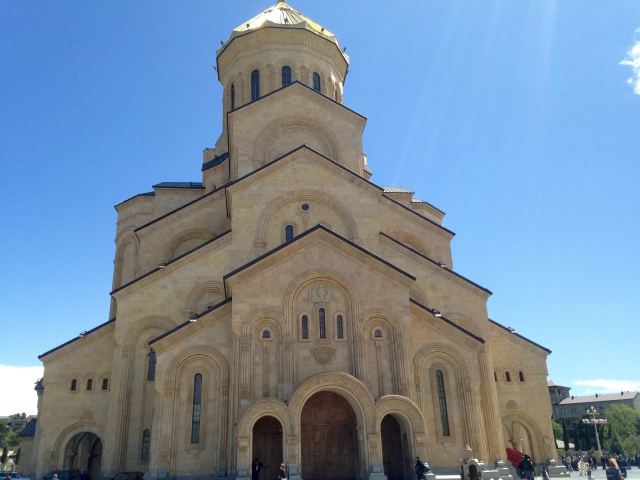
Spending the holidays in Georgia for ten days was a literal breath of fresh air, a breath of freedom. It was so good to gain new experiences in regards to culture, art, food and sites. My trip was also a spiritual journey for me, a pilgrimage of some of the holy sites of Georgia. I lit candles and prayed at every church and monastery that I visited, thanking the Lord of the blessings and people in my life. I’m so thankful to have had the opportunity to see this remarkable country again and really get into the feel of things, having a supra and sharing drink with my friends. Well, I hope that my record of Georgia has been interesting for you all. I have one more month in Russia and I hope to have a few more stories to tell before I leave. Cheers to you all, from Russia with regards.

